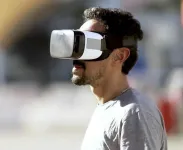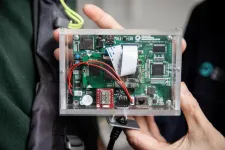(Press-News.org) Nuclear fusion offers the potential for a safe, clean and abundant energy source.
This process, which also occurs in the sun, involves plasmas, fluids composed of charged particles, being heated to extremely high temperatures so that the atoms fuse together, releasing abundant energy.
One challenge to performing this reaction on Earth is the dynamic nature of plasmas, which must be controlled to reach the required temperatures that allow fusion to happen. Now researchers at the University of Washington have developed a method that harnesses advances in the computer gaming industry: It uses a gaming graphics card, or GPU, to run the control system for their prototype fusion reactor.
The team published these results May 11 in Review of Scientific Instruments.
"You need this level of speed and precision with plasmas because they have such complex dynamics that evolve at very high speeds. If you cannot keep up with them, or if you mispredict how plasmas will react, they have a nasty habit of going in the totally wrong direction very quickly," said co-author Chris Hansen, a UW senior research scientist in the aeronautics and astronautics department.
"Most applications try to operate in an area where the system is pretty static. At most all you have to do is 'nudge' things back in place," Hansen said. "In our lab, we are working to develop methods to actively keep the plasma where we want it in more dynamic systems."
The UW team's experimental reactor self-generates magnetic fields entirely within the plasma, making it potentially smaller and cheaper than other reactors that use external magnetic fields.
"By adding magnetic fields to plasmas, you can move and control them without having to 'touch' the plasma," Hansen said. "For example, the northern lights occur when plasma traveling from the sun runs into the Earth's magnetic field, which captures it and causes it to stream down toward the poles. As it hits the atmosphere, the charged particles emit light."
The UW team's prototype reactor heats plasma to about 1 million degrees Celsius (1.8 million degrees Fahrenheit). This is far short of the 150 million degrees Celsius necessary for fusion, but hot enough to study the concept.
Here, the plasma forms in three injectors on the device and then these combine and naturally organize into a doughnut-shaped object, like a smoke ring. These plasmas last only a few thousandths of a second, which is why the team needed to have a high-speed method for controlling what's happening.
Previously, researchers have used slower or less user-friendly technology to program their control systems. So the team turned to an NVIDIA Tesla GPU, which is designed for machine learning applications.
"The GPU gives us access to a huge amount of computing power," said lead author Kyle Morgan, a UW research scientist in the aeronautics and astronautics department. "This level of performance was driven by the computer gaming industry and, more recently, machine learning, but this graphics card provides a really great platform for controlling plasmas as well."
Using the graphics card, the team could fine-tune how plasmas entered the reactor, giving the researchers a more precise view of what's happening as the plasmas form -- and eventually potentially allowing the team to create longer-living plasmas that operate closer to the conditions required for controlled fusion power.
"The biggest difference is for the future," Hansen said. "This new system lets us try newer, more advanced algorithms that could enable significantly better control, which can open a world of new applications for plasma and fusion technology."
INFORMATION:
Additional co-authors on this paper are Aaron Hossack, a UW research scientist in the aeronautics and astronautics department; Brian Nelson, a UW affiliate research professor in the electrical and computer engineering department; and Derek Sutherland, who completed a doctoral degree at the UW but is now the CEO of CTFusion, Inc. This research was funded by the U.S. Department of Energy and by CTFusion, Inc., through an Advanced Research Projects Agency-Energy award.
For more information, contact Hansen at hansec@uw.edu and Morgan at morgak@uw.edu.
Grant numbers: SC-0018844, DE-AR0001098
As any juror will tell you, piecing together a crime from a series of documents tendered in a courtroom is no easy feat, especially when a person's future hangs in the balance.
Delivering the correct verdict on car accident and murder cases is contingent on good spatial awareness, but short of being at the scene of the crime, the room for error is large.
However, thanks to the advent of virtual reality (VR), jurors now have a better chance of making the right decision.
A new study published by the University of South Australia provides overwhelming evidence ...
The discovery of a Roman road submerged in the Venice Lagoon is reported in Scientific Reports this week. The findings suggest that extensive settlements may have been present in the Venice Lagoon centuries before the founding of Venice began in the fifth century.
During the Roman era, large areas of the Venice Lagoon which are now submerged were accessible by land. Roman artefacts have been found in lagoon islands and waterways, but the extent of human occupation of the lagoon during Roman times has been unclear.
Mapping the lagoon floor using sonar, Fantina Madricardo and colleagues discovered 12 archaeological structures aligned in a northeasterly direction for 1,140 metres, in an area of the lagoon ...
Newly-hatched pterosaurs may have been able to fly but their flying abilities may have been different from adult pterosaurs, according to a study published in Scientific Reports.
Pterosaurs were a group of flying reptiles that lived during the Triassic, Jurassic and Cretaceous Periods (228 to 66 million years ago). Due to the rarity of fossilised pterosaur eggs and embryos, and difficulties distinguishing between hatchlings and small adults, it has been unclear whether newly-hatched pterosaurs were able to fly.
Darren Naish and colleagues modelled hatchling flying abilities using previously obtained wing measurements from four established hatchling and embryo fossils from two pterosaur species, ...
Gene therapy in mouse models showed promise in preventing vision loss or blindness from serious retinal injury including optic nerve damage, and from retinal disease including diabetic retinopathy and glaucoma, Mount Sinai researchers report. Their study, published in the July 22 online publication of Cell, could transform treatment for those at risk of major vision loss from retinal degenerative diseases, which currently have no cure.
The researchers focused on retinal ganglion cells, which process visual information by sending images to the brain. These cells can degenerate as a result of retinal injury and retinal disease. ...
Geneticists from Trinity College Dublin have discovered how a specific genetic mutation called H3K27M causes a devastating, incurable childhood cancer, known as diffuse midline glioma (DMG), and - in lab studies working with model cell types - successfully reverse its effects to slow cancer cell growth with a targeted drug.
Their landmark work - just published in leading international journal, Nature Genetics and supported by Worldwide Cancer Research and The Brain Tumour Charity - translates crucial new understanding of the genetics of DMG progression into ...
A form of gene therapy protects optic nerve cells and preserves vision in mouse models of glaucoma, according to research supported by NIH's National Eye Institute. The findings suggest a way forward for developing neuroprotective therapies for glaucoma, a leading cause of visual impairment and blindness. The report was published in Cell.
Glaucoma results from irreversible neurodegeneration of the optic nerve, the bundle of axons from retinal ganglion cells that transmits signals from the eye to the brain to produce vision. Available therapies slow vision loss by lowering elevated eye pressure, however some glaucoma progresses to blindness despite normal eye pressure. Neuroprotective therapies would be a leap forward, meeting ...
Advances in microscopy have enabled researchers to picture loops of DNA strands for the first time. The images reveal how the human genome organises itself in three-dimensional space at much higher resolution than previously possible.
The findings, published in a new study in the journal Molecular Cell, also reveal that the process of DNA being copied into RNA - transcription - indirectly shapes the architecture of the genome. An international team led by Pia Cosma at the Centre for Genomic Regulation (CRG) in Barcelona and Melike Lakadamyali at the Perelman ...
Manipulating RNA can allow plants to yield dramatically more crops, as well as increasing drought tolerance, announced a group of scientists from the University of Chicago, Peking University and Guizhou University.
In initial tests, adding a gene encoding for a protein called FTO to both rice and potato plants increased their yield by 50% in field tests. The plants grew significantly larger, produced longer root systems and were better able to tolerate drought stress. Analysis also showed that the plants had increased their rate of photosynthesis.
"The change really is dramatic," said University of Chicago Prof. Chuan He, who together with Prof. Guifang Jia at Peking University, led ...
A new study showed that a wearable computer vision device can reduce collisions for both people who are blind or those who are visually impaired and using a long cane and/or guide dog by 37 percent, compared to using other mobility aids alone.
People who have visual impairments are at a significantly higher risk for collisions and falls. Commonly used mobility aids like long canes and guide dogs can offer benefits, but come with limitations in effectiveness and costs, respectively. While some electronic devices are marketed direct-to-consumer claiming to warn wearers of surrounding objects, there has been little evidence of their effectiveness in actual daily mobility settings. This is one of the first randomized-controlled trials to look at the potential benefit of the ...
What The Study Did: This study included 647 patients with untreated nonmetastatic prostate cancer (269 patients during the pandemic and 378 from before the pandemic). During the initial COVID-19 lockdown, only 1% of Black men underwent prostatectomy, while 26% of white patients did. Prior to the pandemic, there was no difference in the rate of prostatectomy between the two races (18% of Black men and 19% of white men). The lessons from this study suggest systemic inequities within health care and are likely applicable across medical specialties. Public health efforts are needed to fully recognize the unintended consequence of diversion of cancer resources to the COVID-19 pandemic to develop balanced mitigation strategies as viral rates continue to fluctuate.
Authors: ...


